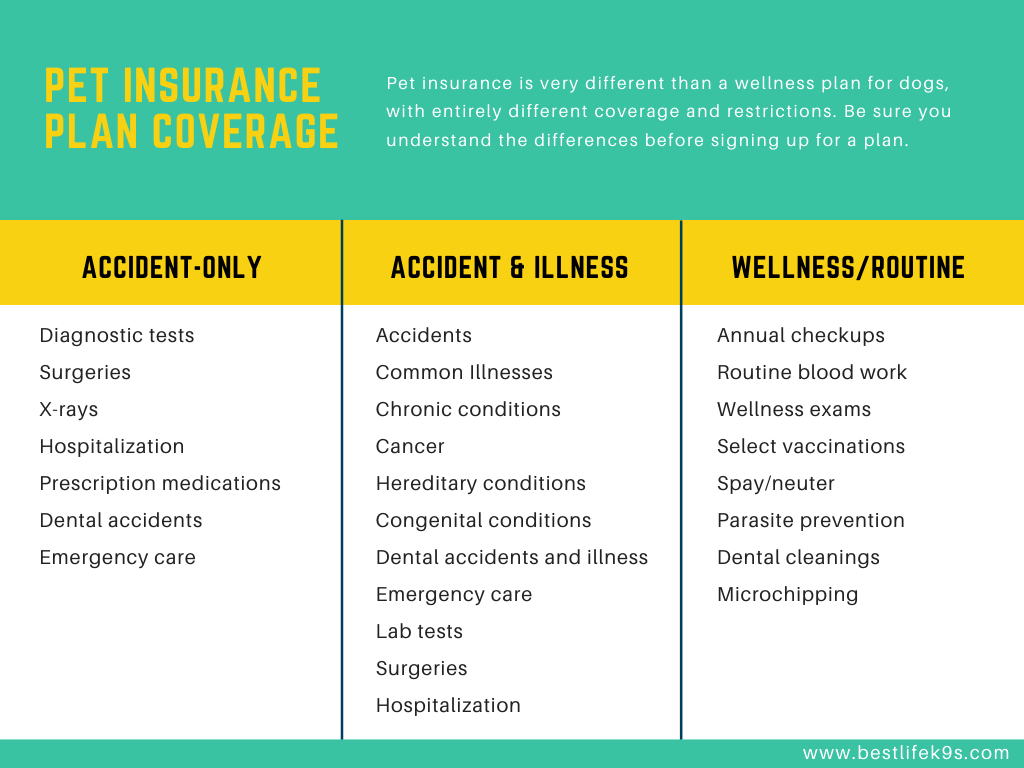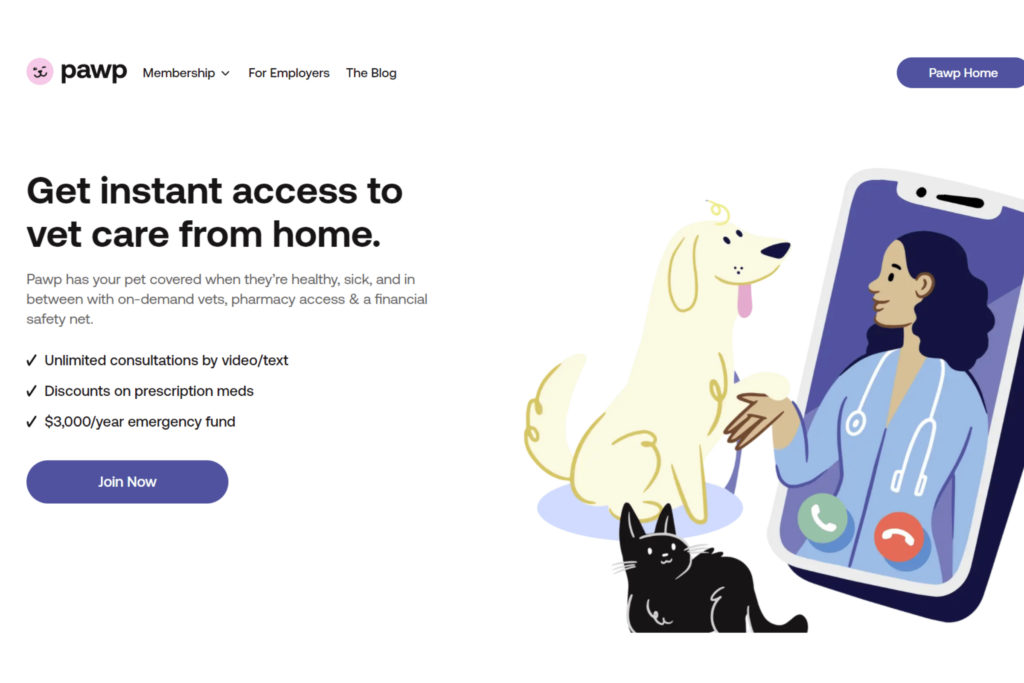Did you know a pet receives emergency medical care every 2.5 seconds in the U.S.? In fact, one in three pets needs emergency veterinary treatment every year! (MetLife Pet Insurance)
In the event your dog experiences an unexpected accident, illness, or emergency, are you prepared for a vet bill that can cost thousands to tens of thousands of dollars?
Unexpected veterinary bills happen – it’s part of being a pet parent. But having dog pet insurance for your pup can give you peace of mind and safeguard against these unforeseen costs by paying for a portion of your pet’s medical bills based on your plan’s coverage.

What is Pet Insurance for Dogs?
Simply put, pet insurance is a form of health insurance for dogs, cats, and other animals. It’s a policy purchased by a pet parent to offset the overall cost of their animal’s unexpected medical bills.
Unlike human healthcare insurance, pet insurance is based on owner reimbursement. This means you can use any licensed veterinarian, clinic, emergency animal hospital, or specialist in the U.S. because there is no network or approved provider restrictions.

With pet insurance for dogs, you typically pay expenses in full to your veterinarian first, and then you would submit a claim with your pet insurance provider in order to be reimbursed. Some insurance companies even reimburse your pup’s veterinarian directly, but we’ll get to that shortly.
Let’s dig into the details to break down pet insurance even further!
Pet Insurance vs. Wellness Plans
Pet insurance is very different than a wellness plan for dogs, with entirely different coverage and restrictions.
Unlike pet insurance, which helps pay for the costs associated with unexpected injuries and illnesses, wellness plans for pets cover the expected costs of preventative care.
A wellness plan for dogs is intended for routine veterinary care you know your pet will need (like annual exam fees and vaccines).
What is the Average Cost of Pet Wellness Plans?
Because the costs associated with wellness plans for pets are typically lower, known, and easier to budget for, wellness plans aren’t as popular as pet insurance, which can save your bank account from taking more of a big hit.
But just because wellness and preventative care costs are typically much lower than accident or illness bills, that doesn’t always mean pet wellness plan costs are less than insurance plans. Some wellness plans can cost just as much or more than insurance premiums, depending on the carrier.
The pet parents who have both kinds of coverage don’t have as much to worry about in the way of expected and unexpected pet care costs except scheduling monthly payments and submitting claim filings.
With pet wellness plans, you can expect to pay, on average, between $25-55 per month, per dog.

What Does Pet Insurance Cover?
Most pet insurance plans cover unexpected injuries and illnesses, surgery, medication, tests/diagnostics, emergency care, and exam fees, but not every policy is created equal.
The details of your pet insurance policy will depend on the type of coverage and the provider you choose (plus some other factors related to your dog).
Keep reading for an explanation of pet insurance plans, what they cover, and what they do not cover.
Types of Pet Insurance Plans
Accident-only Coverage – This type of policy covers certain medical expenses if your pet suffers an accident that results in an injury such as a broken bone. Coverage might include diagnostic tests, surgeries, X-rays, hospitalization, prescription medications, and emergency care.
Accident and Illness Coverage – This type of policy helps pay for vet bills that arise from unexpected incidents such as sprains from accidents, poisonings, and common illnesses, such as ear infections. This kind of plan might also cover lab tests, surgeries, hospitalization, prescription medications, and emergency care.
Wellness Plans – As mentioned earlier, wellness pet plans are not pet insurance, but they can be added to some pet insurance policies for an additional fee.
With the right pet insurance policy, you can take comfort in knowing the risk is transferred to your provider and that you are protected from high unpredicted costs.
If you’re still not sure which plan is best for your pet, ask your vet for his feedback based on his or her history with your dog.
What Does Pet Insurance Not Cover?
Coverage restrictions vary between providers, but the majority of them do not cover pregnancy or breeding, vaccinations, and never pre-existing conditions. See the full list below.

What is the Average Cost of Pet Insurance?
For dog owners, the monthly cost of pet insurance can range from $20 to $100, but on average pet parents can expect to spend between $30 and $50 per month for one dog.
In addition to the amount of coverage you choose, the premium (aka monthly cost for your policy) depends on the:
Over one-third (37%) of dog owners haven’t considered pet insurance because they think it will be too expensive.
Forbes Advisor survey
Over one-third (37%) of dog owners haven’t considered pet insurance because they think it will be too expensive, according to a Forbes Advisor survey. Yet 89% of dog owners estimate that the cost of pet insurance is higher than it actually is. And 76% of dog owners overestimate the cost of pet insurance by at least three times the average price, the Forbes Advisor survey found. (Forbes Advisor)
Some providers also offer multiple-pet or military discounts (usually around 5 to 10%). Other discounts (depending on the provider) are offered for AAA members, shelter pet adoptions, and therapy dogs.
Get to Know Pet Insurance Lingo
Insurance can be confusing, whether it’s for humans or animals, and confusion can lead to costly mistakes when selecting a healthcare plan. To help you avoid that, I review some commonly used insurance terms and their meanings below.

Insurance Carrier – Another name for insurance company. These terms are often used interchangeably.
Premium – The price you pay for your dog’s insurance policy (paid monthly or annually).
Annual Limit or Maximum – The maximum amount pet insurance carriers will reimburse you per pet in a period of insurance. The annual maximum does not include the deductible and copay amounts you pay.
Waiting Periods – A brief period of time (usually 14 days) at the beginning of a policy when coverage is restricted. This means you will not receive reimbursement for claims filed during the waiting period.
The purpose of waiting periods is to prevent fraud – it’s basically a way for insurance companies to protect their business. They don’t want people receiving an insurance payout on a pre-existing condition or accident that occurred before the policy was purchased. Some carriers even have a six-month waiting period for issues like hip dysplasia.
Unfortunately, pet insurance with no waiting period is near impossible to come by. Companion Protect is the only provider I’m aware of that offers that benefit. You can expect full coverage from the moment you enroll with Companion Protect (excluding coverage for annual wellness exams, which have a six-month waiting period).
Deductibles – A deductible is the amount of money you pay out of pocket every year to a veterinarian before your pet insurance policy coverage starts. Pet insurance deductibles range from $0 to $1,000.
As a standard, the higher your deductible the less you pay in pet insurance costs (and vice versa).
See the reimbursement example below for a better look at how deductibles work.
Claims – An insurance claim is a formal request to your pet insurance provider for reimbursement against expenses covered under your insurance policy.
To file a claim with your pet insurance provider, you will either need to send them an email with your claim form and expense invoice or log in to your account portal to upload those items and complete a questionnaire.
Reimbursement – This is the amount a pet insurance company pays you for your veterinary expenses. It is expressed as a percentage depending on the plan you choose.
The most popular pet insurance plans have a reimbursement of 80% to 90% of your total vet bills, but be aware that the higher the reimbursement, the higher your monthly cost will be.
It’s also important to note that you won’t be reimbursed for any expenses until you’ve met the out-of-pocket deductible for your plan.
As an example, let’s say you have a dog pet insurance plan with a $500 deductible and 80% reimbursement.
If your dog had a medical procedure that cost $3,000 (and it’s your first claim), you would pay the full $3,000 to the vet who performed the procedure. The first $500 of that payment would satisfy your deductible, so after filing a claim, you’d then be reimbursed 80% of the remaining $2,500, which is $2,000.
Getting two-thirds of your original expense back would be such a relief!
Lifetime Limit – The maximum amount your insurance will reimburse you over your dog’s lifetime. Some pet insurance companies do not have a lifetime limit.
Pre-existing Condition – A condition in your dog that began before its policy start date or prior to the end of the waiting periods. An example of this would be hip dysplasia. Unfortunately, there are no pet insurance providers that cover pre-existing conditions.
Bilateral Condition – A condition or disease that affects both sides of a dog’s body. This is oftentimes covered as long as it’s not a pre-existing condition your dog has before signing up for a pet insurance plan.
Renewal – When your pet’s policy has been active for a year, it will automatically renew. Renewals usually reset the deductible and annual maximum (if it’s not unlimited).
What are the Well-known Pet Insurance Carriers?
There are many great pet insurance companies out there to choose from! I’ve listed 14 of the more widely known dog pet insurance carriers below (in no particular order) along with some of their main benefits to help you narrow down your search.
• Embrace – Known for comprehensive coverage and multi-pet discount
• Pets Best – Known for having a 24/7 vet helpline
• Healthy Paws – Known for quick claims processing
• Fetch (by The Dodo) – Known for excellent customer service
• Trupanion – Known for paying claims directly to veterinarians
• ManyPets – Known for reduced waiting periods for illness and accidents
• Nationwide – Known for exotic pet coverage
• ASPCA Pet Health Insurance – Known for covering hereditary/congenital and chronic conditions
• Figo – Known for a reimbursement option of 100%
• Spot – Known for having no age limit for older animals
• Lemonade – Known for low prices but limited coverage
• Prudent Pet – Known for extra perks in addition to insurance plans
• Trusted Pals – Known for covering cured pre-existing conditions
• Pumpkin – Known for offering one straightforward accident and illness plan
• MetLife – Known for coverage for pets of any age and breed
Alternatives to Pet Insurance
If you have a senior dog, pet insurance may not be right for your family, though some pet insurance companies do not have age limits.
Elderly dogs that have already experienced health issues such as cancer or loss of mobility may not see enough value from a new insurance plan since pre-existing conditions are not covered. In this case, one of the below alternatives to pet insurance may be best.
Before you decide if dog pet insurance is right for you, take a look at the alternatives that offer affordable illness or accident coverage, oftentimes at a lower cost than conventional pet insurance plans.

Pawp – Pawp is not pet insurance; it’s a $24/month membership that gives you access to an emergency fund. Pawp covers one emergency vet bill up to $3,000 per household per year. There is no copay or deductible. The nice thing about Pawp is they will cover emergencies related to a pre-existing condition.
Pet Assure – A veterinary discount plan that is only available as an employee benefit through employers. Show your Pet Assure card at participating veterinary practices to get a 25% discount on all medical care provided in the office by the veterinary staff.
Eusoh – A community health sharing plan that reimburses you for your pet’s medical, wellness, illness, and routine care expenses (based on national average pricing).
CareCredit – The CareCredit credit card offers no-interest and low-interest payment plans. Your veterinarian must offer this service for you to use it.
Savings Account – With this option, you can save as little or as much as you want while earning interest on your balance. Consistent contributions are key to building up enough savings for your dog(s) vet needs.
Now that we’ve covered pet insurance plans, coverage, lingo, alternatives, and more, it’s time to talk about the fine print.
What to Watch Out for When Choosing Pet Insurance
Understanding your pet insurance policy is crucial to ensure you don’t run into any surprises when submitting a claim. Be sure to read the fine print before committing to a dog pet insurance plan.

A few things to watch out for when comparing providers and plans are:
- Annual payout limits
- Rate increases as dogs age
- ‘Lifetime’ or ‘non-lifetime’ policy
- Dental coverage, if any
- Third-party liability coverage
- Exclusions
What Dog Insurance Does Our Family Use?
My husband and I signed up for Pawp this year for our household of four dogs. As I mentioned in an earlier article, Pawp is the membership plan for dogs that covers one accident annually (up to $3,000) per household.

Our Dutch Shepherd, Bear, ends up with at least one injury per year.
The poor guy has ended up with a chemical burn from a stay at a boarding facility, ripped paw pads, lacerated paw, punctured side (a tree branch totally got in his way), and a busted face from a tree he ran into at full speed.
The boy needs to learn how to use his brakes!
We’ve recently been considering health insurance for our pups. When researching insurance companies, we focused on accident and illness plans (no wellness plans). Multi-dog discounts are also important to us, as well as an annual coverage limit of $15,000 up to unlimited.
Here’s the breakdown for our four dogs:
• $155/month (total for all 4 dogs)
• $500 deductible
• 80% reimbursement
This essentially means we would be guaranteed to spend $1,860 per year on premiums, plus the $500 deductible if an accident or illness called for the spend. This is all in addition to annual wellness vet visits, preventative vaccines, and flea, tick and heartworm meds, etc. In total, for insurance (including the deductible spend) and preventative care, we’re looking at just around $4,000 per year.
I’m not saying we’ll never get pet insurance for our pack, but currently it doesn’t sense financially for us. Though neither would expensive illnesses, so never say never!
What is the Best Insurance Plan for Your Dog?
Now that you know what to look for when getting dog pet insurance, what do you feel is the best insurance (or alternative to pet insurance) for your canine?

There are many important factors to consider when deciding if pet insurance is right for your dog, as well as which policy is the best fit. While some people shop around for a policy with a shorter waiting period, it’s best to choose a plan that offers the best coverage and value for your dog’s needs.
You can find many detailed dog insurance comparisons online, which offer a comprehensive analysis of each company and rankings for the best pet insurance for a variety of scenarios (i.e. best pet insurance for pre-existing conditions, elderly dogs, puppies, multiple pets, people on a budget, and more).
Conclusion
Most of us (myself included!) consider our dogs to be family. If a pet emergency arises, you shouldn’t have to decide between your dog’s health and putting food on the table. Having insurance for pets can be a lifesaver (literally) and alleviate unanticipated vet bills.

Now that you’ve gotten the low down on pet insurance, what it covers, and approximate monthly costs, do you feel pet insurance is right for your dog? Let me know in the comments!
